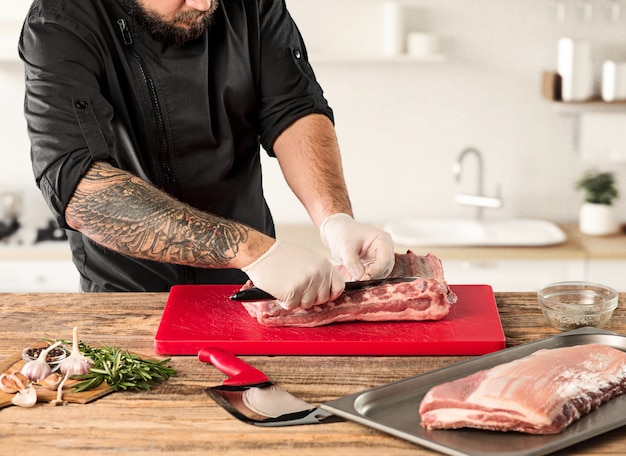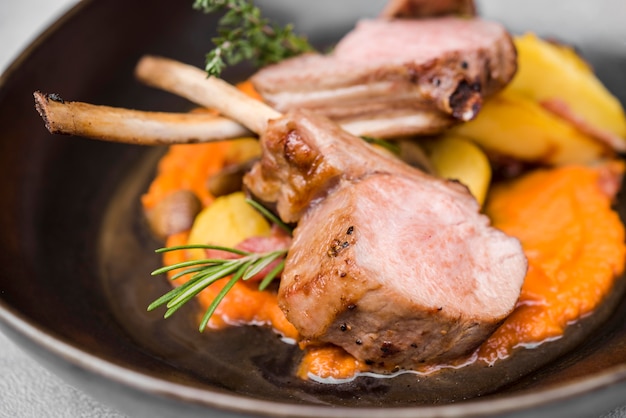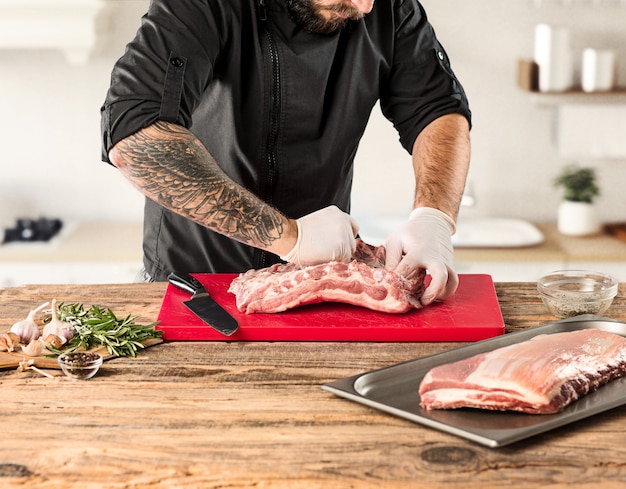Let's talk pork loin, shall we? It's a real crowd-pleaser, isn't it? I mean, who doesn't love a good roast or a succulent cut of pork? I've certainly had my fair share of dry, tough pork loin experiences, leaving me feeling a bit disappointed. But don't worry, I'm here to share my secrets, my tried-and-true methods for cooking pork loin that will leave you saying, "That was amazing!" I'm talking tender, juicy, and bursting with flavour - the kind of pork loin that'll have everyone asking for seconds. So, buckle up, grab your apron, and let's get cooking!
(Part 1) Choosing the perfect pork loin

Knowing Your Cuts: Bone-in or Boneless?
First things first, you need to choose your pork loin. Now, there are two main contenders: bone-in and boneless. I'm a firm believer in bone-in pork loin. It has a richer flavour, and the bone helps to keep the meat moist during cooking. It's often a bit more affordable too. Boneless, on the other hand, is great for slicing and grilling, as it's more versatile for different cooking methods. Ultimately, it's down to personal preference and what you're planning to make.
Size Matters: How Much Do You Need?
When it comes to size, you've got to consider how many people you're feeding. A standard pork loin will feed about 4-6 people. If you're cooking for a larger crowd, you might need to pick up a couple. A good rule of thumb is to plan for about 1 pound per person. If you're unsure, it's always better to err on the side of too much rather than too little. No one wants to be left hungry!
Look for the Right Colour and Texture:
Now, you want to make sure you're buying a good quality piece of pork. Look for a loin that has a pale pink colour, with some marbling (that's the white fat streaks) for added flavour and moisture. Avoid any pork that has a grayish hue or feels slimy to the touch. The texture should be firm and springy, not mushy or soft. A good butcher can offer advice on selecting a quality cut.
(Part 2) Preparing Your Pork Loin for Cooking

Get That Skin Crisp: The Importance of Scoring
Right, now that you've got your pork loin, let's get it ready to cook. One of my go-to techniques for elevating the flavour and making it even more beautiful is to score the fat. What's scoring? It's simply making small cuts in the fat, like a criss-cross pattern. This helps the fat render out during cooking, which creates that lovely crispy skin we all love. It also allows the flavours to penetrate deeper into the meat, giving it a richer taste. Just be careful not to cut too deep into the meat.
Seasoning Secrets: What Flavours Work Best?
Next, let's talk seasoning. Pork loin is so versatile; it takes on flavours beautifully. For a classic flavour profile, I love a simple rub of salt, pepper, and garlic powder. But you can get really creative with it. Here are some of my go-to flavour combinations:
- Herb-infused: A mix of rosemary, thyme, and sage adds a beautiful aromatic touch. I love to add a bit of fresh rosemary sprigs to the roasting pan for an extra burst of flavour.
- Mediterranean Delight: Combine oregano, basil, and lemon zest for a bright and tangy flavour. You can even add a drizzle of olive oil and a squeeze of lemon juice before roasting for extra zing.
- Spicy Kick: A blend of paprika, cayenne pepper, and cumin delivers a fiery kick. For a smoky touch, try adding a pinch of smoked paprika.
Don't be afraid to experiment! It's all about finding what you enjoy. Try adding some brown sugar to your rub for a touch of sweetness, or a bit of mustard powder for a tangy kick.
(Part 3) Cooking Pork Loin to Perfection: Different Methods Explained

Method 1: Roasting to Tenderness
Roasting is probably the most popular way to cook pork loin. It's simple, fuss-free, and delivers juicy results. Here's how I do it:
- Preheat your oven to 350°F (175°C).
- Place your seasoned pork loin in a roasting pan.
- Add a cup of water or broth to the bottom of the pan to help keep the meat moist. You can also add some chopped vegetables, like carrots or onions, for extra flavour.
- Roast for 45-60 minutes, or until the internal temperature reaches 145°F (63°C). For a really succulent pork loin, try cooking it at a lower temperature, like 325°F (160°C), for a longer time, about 1 hour and 15 minutes.
- Let the pork rest for 10 minutes before carving to allow the juices to redistribute. Cover it loosely with foil to help keep it warm.
Method 2: Pan-Searing for a Crispy Crust
Pan-searing is perfect if you want a crispy crust on your pork loin. It's also a great way to cook a smaller, boneless loin.
- Heat a heavy-bottomed skillet over medium-high heat. A cast iron skillet is ideal for this method, as it retains heat well.
- Season your pork loin with your favourite rub. You can also add a bit of oil to the skillet before searing for a crispy crust.
- Sear the pork for 3-4 minutes per side, or until nicely browned. Don't overcrowd the skillet, as this will lower the temperature and prevent a good sear.
- Reduce the heat to medium and continue cooking for another 10-15 minutes, or until cooked through. You can add some butter or herbs to the skillet towards the end for added flavour.
- Rest the pork for 5 minutes before slicing and serving. Cover it loosely with foil to keep it warm.
Method 3: slow cooking for Tenderness
If you're looking for a hands-off approach, slow cooking is the way to go. It's perfect for creating incredibly tender and flavorful pork loin. Just be sure to use a slow cooker that's big enough to accommodate the size of your pork loin.
- Season your pork loin with your favourite rub. For extra flavour, try adding a few slices of bacon to the bottom of the slow cooker.
- Place the pork in your slow cooker and pour a cup of broth or water into the bottom. You can also add chopped vegetables, like carrots, onions, or potatoes, for a hearty meal.
- Cook on low for 6-8 hours, or on high for 3-4 hours. The longer you cook it, the more tender it will be.
- Remove the pork from the slow cooker and let it rest for 10 minutes before slicing. You can use the juices from the slow cooker to make a delicious sauce.
Method 4: Grilling for Smoky Flavour
For a smoky flavour, grilling is a fantastic option. This is best suited for boneless pork loin, as it will be easier to manage on the grill. Make sure your grill is clean before you start cooking.
- Preheat your grill to medium heat. You can use a gas grill or charcoal grill. For a more intense smoky flavour, use wood chips soaked in water and placed in a smoker box on the grill.
- Season your pork loin with your preferred rub. You can also create a glaze by mixing your rub with a bit of honey or maple syrup.
- Place the pork on the grill and cook for 10-12 minutes per side, or until cooked through. Flip the pork loin once it develops a nice crust.
- Let the pork rest for 5 minutes before slicing. Cover it loosely with foil to keep it warm.
(Part 4) Mastering the Internal Temperature
Understanding the Importance of Doneness
The most important thing when cooking pork loin is to make sure it's cooked to the right temperature. You want to ensure it's safe to eat, but also not overcooked to the point where it becomes dry and tough. The recommended internal temperature for pork loin is 145°F (63°C). Cooking to this temperature ensures that the pork is safe to eat while maintaining its juiciness.
Using a meat thermometer: The Key to Success
To get the most accurate reading, you'll want to use a meat thermometer. You can find them at most grocery stores. Insert the thermometer into the thickest part of the pork loin, making sure it's not touching any bones. The thermometer should be inserted deep enough to reach the centre of the meat. Once the internal temperature reaches 145°F (63°C), you're good to go!
(Part 5) The Resting Period: Let it Breathe!
Once your pork loin is cooked through, it's crucial to let it rest for 10-15 minutes before slicing. This allows the juices to redistribute throughout the meat, resulting in a much more tender and juicy result. Imagine it as giving the pork a chance to catch its breath after its time in the oven or on the grill! Cover the pork loosely with foil to keep it warm and help the juices redistribute.
(Part 6) Delicious side dishes to Accompany Your Pork Loin
Traditional and Savoury:
Pork loin is incredibly versatile; it pairs beautifully with a wide range of side dishes. Some of my personal favourites include:
- Roasted vegetables, like potatoes, carrots, and onions. For a flavourful twist, try roasting the vegetables with herbs like rosemary, thyme, or sage.
- Creamy mashed potatoes. Add a knob of butter and some fresh herbs for extra richness.
- Savoury rice pilaf. A simple rice pilaf with onions, garlic, and herbs is a classic accompaniment for pork loin.
- green beans with almonds. Roasted or steamed green beans tossed with toasted almonds and a sprinkle of salt and pepper are a delightful contrast to the richness of the pork.
- asparagus with lemon and parmesan. Grilled or roasted asparagus drizzled with lemon juice and topped with Parmesan cheese is a light and flavourful side dish.
Fresh and Light:
If you're feeling a bit lighter, there are plenty of fresh and vibrant side dishes that complement the pork perfectly:
- A refreshing salad with vinaigrette dressing. Try a simple salad with mixed greens, cherry tomatoes, and cucumbers, tossed with a light vinaigrette dressing.
- fruit salad with a drizzle of honey and balsamic glaze. A colourful fruit salad with berries, melon, and pineapple, drizzled with a touch of honey and balsamic glaze is a sweet and tangy contrast to the savoury pork.
- grilled corn on the cob. Grilled corn on the cob with a sprinkle of salt and pepper is a simple and delicious side dish.
(Part 7) Creative Ways to Use leftover pork loin
Let's be honest, sometimes you end up with leftover pork loin. But don't despair! There are so many delicious ways to use it up. Here are a few of my go-to recipes:
Sandwiches and Wraps:
- Pork loin sandwiches with caramelized onions and tangy mustard. Slice the leftover pork loin thinly and layer it on toasted bread with caramelized onions and a dollop of tangy mustard for a satisfying sandwich.
- Pork loin wraps with fresh vegetables and a creamy avocado spread. Slice the leftover pork loin thinly and add it to a tortilla with fresh lettuce, tomatoes, and a creamy avocado spread for a light and flavorful wrap.
Salads and Bowls:
- Pork loin salad with mixed greens, dried cranberries, and toasted walnuts. Slice the leftover pork loin thinly and add it to a mixed green salad with dried cranberries and toasted walnuts for a satisfying and nutritious meal.
- Pork loin noodle bowl with soy sauce, ginger, and sesame oil. Shred the leftover pork loin and add it to a bowl of noodles with soy sauce, ginger, and sesame oil for a quick and flavourful meal.
Soups and Stews:
- Pork loin and lentil soup with a hint of smoky paprika. Shred the leftover pork loin and add it to a lentil soup with a hint of smoky paprika for a hearty and comforting meal.
- Pork loin stew with root vegetables and herbs. Dice the leftover pork loin and add it to a stew with root vegetables like carrots, potatoes, and onions, and herbs like thyme and rosemary for a comforting and flavorful meal.
(Part 8) Tips and Tricks for Success
Avoid Overcooking:
The biggest mistake you can make when cooking pork loin is overcooking it. overcooked pork becomes dry and tough, so make sure you cook it to the right temperature and don't overcook it. Remember, it's always better to undercook slightly and let it rest for a few extra minutes. That way, you can be sure it's safe to eat and still tender and juicy.
Don’t Be Afraid of the Fat:
The fat in pork loin is actually a good thing! It adds flavour and moisture to the meat. Don't trim it off completely. Just try to score the fat to help it render out during cooking. If you're concerned about the fat content, you can trim off some of the excess fat, but leave a thin layer for flavor and moisture.
Use a Good Quality Thermometer:
If you're serious about cooking pork loin to perfection, invest in a good quality meat thermometer. It will take the guesswork out of cooking and ensure that your pork is always cooked to the right temperature. You'll be happy you did!
Embrace the Flavour:
Pork loin is a blank canvas for flavour. Don't be afraid to get creative with your seasonings and rubs. Experiment with different herbs, spices, and flavour combinations to find what you enjoy. I've included some of my favourite flavour combinations earlier in the guide. You can also try marinating the pork loin before cooking for even more intense flavour.
(Part 9) FAQs
Q1. How do I know if my pork loin is cooked through?
The best way to determine if your pork loin is cooked through is by using a meat thermometer. Insert the thermometer into the thickest part of the pork loin, making sure it doesn’t touch any bones. The internal temperature should reach 145°F (63°C). You can also check for doneness by making a small cut in the middle of the pork loin. The juices should run clear, not pink. If the juices are still pink, the pork needs to cook a bit longer.
Q2. Can I cook a pork loin from frozen?
It's not recommended to cook a pork loin from frozen. It's best to thaw it in the refrigerator overnight before cooking. This will ensure that the pork cooks evenly and reaches the right temperature. However, if you're in a pinch, you can thaw a pork loin in cold water. Submerge the pork in a bowl of cold water, changing the water every 30 minutes. It should take about 30 minutes per pound to thaw. But, again, it's best to plan ahead and thaw it in the fridge overnight.
Q3. How long should I rest my pork loin after cooking?
After you’ve cooked your pork loin, it's crucial to let it rest for 10-15 minutes before slicing. This allows the juices to redistribute throughout the meat, resulting in a much more tender and juicy result.
Q4. Can I cook a pork loin in a slow cooker?
Yes, you can definitely cook a pork loin in a slow cooker. It's actually a great way to cook pork loin, as it yields incredibly tender and flavorful results. Just season your pork loin with your favourite rub, place it in the slow cooker, and pour a cup of broth or water into the bottom. Cook on low for 6-8 hours, or on high for 3-4 hours. Remove the pork from the slow cooker and let it rest for 10 minutes before slicing. You can then use the juices from the slow cooker to make a delicious sauce.
Q5. What are some creative ways to use leftover pork loin?
There are so many delicious ways to use leftover pork loin! You can slice it thinly and add it to salads, sandwiches, wraps, or pasta dishes. You can also shred it and use it in soups, stews, or tacos. Leftover pork loin is also great in stir-fries and rice bowls. Get creative and experiment with different flavour combinations. The possibilities are endless!
I hope this guide has given you all the information you need to cook a delicious and impressive pork loin. Remember, it's all about choosing the right cut, prepping it properly, and cooking it to the right temperature. With a little practice, you'll be a pork loin pro in no time! So, what are you waiting for? Get into the kitchen and get cooking! You won't regret it!
Everyone is watching

How to Cook Frozen Lobster Tails Perfectly: A Step-by-Step Guide
RecipesLobster. Just the word conjures up images of lavish meals, special occasions, and a taste of luxury. But let's...

Pigs in a Blanket Cooking Time: How Long to Bake for Perfect Results
RecipesAh, pigs in a blanket. Just the name conjures up images of those delightful little parcels of crispy pastry en...

Pork Fillet Cooking Time: How Long to Cook It Perfectly
RecipesPork fillet, or tenderloin as it's sometimes called, is a real favourite in our house. It's so versatile, and...

The Ultimate Guide to Cooking Delicious Frankfurters
RecipesLet's face it, we all love a good frankfurter. It's a classic, simple, and always satisfying. But let's be rea...

The Ultimate Guide to Tender, Juicy Pulled Pork
RecipesRight, let's talk pulled pork. It's one of those dishes that just screams "comfort food," doesn't it? I mean...
